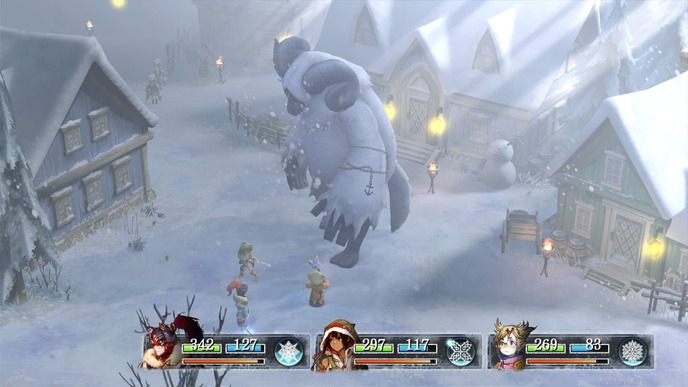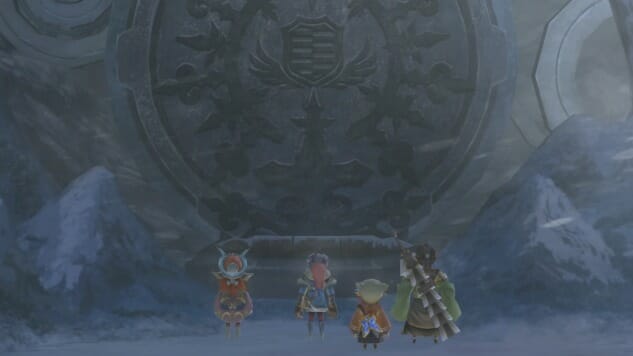When I was younger and more devout, my family attended church every Sunday. A nice Episcopalian church, which if you’ve never heard of it, is often described as Catholic Light. It was filled with friends, other families and people I’d grown up around, and I always enjoyed it for a time.
But there’s something interesting about Episcopalian sermons: they operate on a cycle. They repeat. Not the sermon itself, necessarily, but the readings and teachings. There’s always a Christmas season, Advent and Lent. As I grew up, I could recite them by memory, like I could the hymns and liturgy—and it wore on me.
I Am Setsuna is a role-playing game, one styled after the kind I would have been playing in those early years. Made by Tokyo RPG Factory, a new Square Enix studio formed to create games that hearken back to the Good Ol’ Days, its creators have been happy to list classics like Chrono Trigger as influences for this new game.
Setsuna is immediately reminiscent of any RPG from the SNES era, with systems and mechanics that feel lifted directly from those games. The battle system itself is a carbon-copy of Chrono Trigger’s, with an added timed-button-press component to make it feel like an evolution, rather than a replication. There are even attacks wholly lifted from the game, like X-Strike. It’s hard to draw the line between loving reference and plagiarism at times in this game.
The story is rather underwhelming for the most part. You are a silent, masked protagonist who somehow earns the trust and friendship of every person he meets. Endir (the default name for your hero) is sent to kill Setsuna, the eponymous heroine who is about to leave on a pilgrimage for the Last Lands, in order to sacrifice herself to stave off monster attacks on the land’s people for a few more years. No matter what your character chooses, you offer your sword to Setsuna and accompany her, travelling across the continent to gather a party and get to the ancient kingdom.
Yes, it’s a plotline mimicking Final Fantasy X, with a dash of other RPGs thrown in for flavor. Your party is predictable as well: a grizzled samurai with a hard past, a child prodigy mage with a fatal flaw, a ruler struggling to reclaim her people’s land. The narrative moves, and at times even engages, but rarely offers anything fresh or exciting.
Like my Sundays in church, after years of growing up and hearing them over and over, I Am Setsuna is the recurring liturgy of the classic JRPG.
A silent protagonist does little to endear me to the character, nor does it create a good player-insert. Re-using the battle system of games-gone-by just reminds me of how excellent those games were, and put up against the greats, Setsuna cannot overcome its own shadow.
But I Am Setsuna does not want to overcome or overshadow. Through how often it invokes the likenesses and nostalgia of its ancestors, it wants you to think fondly on them, because without that legacy, it falls flat. I Am Setsuna is afraid to do something wrong, to bleed out of the mold that defined its form, to alter the routine. But it often fails at capturing what made those games incredible in the first place.

The entirety of Setsuna’s world is covered in snow and ice, a white backdrop that could symbolize innocence and sacrifice—if it wasn’t so prevalent in every inch of the world. Towns repeat themselves, buildings look the same, villagers are given arbitrary names unless they’re quest-important (and even then, some still go by titles like Aspiring Researcher rather than a proper noun). There are no vibrant jungles, scorching deserts or beautiful vistas here. Just a lot of plodding around in snow, with the occasional ice cave for dungeons.
Accompanying this is a soundtrack performed by a solo pianist, Randy Kerber. Despite being well-composed and performed, it also misunderstands the weight of the “solo piano interlude” in games, and how expressive previous soundtracks were. If every song in Final Fantasy X was “To Zanarkand,” it wouldn’t stand out so much amongst the score. The weight of those moments is lost when every song is the same arrangement, same composition and same melody, over and over.
Even in replicating role-playing games, I Am Setsuna foregoes basic innovations. Save points are used for almost no reason, and so sparingly that it feels malicious. Most details are obscured or never explicitly told, as it took over 15 hours into the game for me to figure out how cooking works. I Am Setsuna practically assumes you know what it is, what it’s doing, and that you know how to do all of it.
There’s room for that, no doubt. Though I despised it at times, I was at least somewhat pleased with the end of Setsuna’s pilgrimage, despite an unnecessary boss rush at the last minute. This is JRPG comfort food, the kind that won’t replace your favorite meal but works in a pinch. But it’s also indicative of a greater nostalgia for games that can be, at times, too reverent.
It’s that church—except now, I’m older. I’m asking why we keep reading the same scriptures, singing the same songs, doing everything the same when the world certainly isn’t. I’m wondering why Setsuna can’t innovate, grow or become something that others games would imitate. Yet I’m met with the same response, from the many church-goers who don’t want that. They want the same thing they’ve heard before, slightly repackaged, but wholly recognizable and safe. It’s that hushed reverence that creates games like I Am Setsuna, and ultimately holds them back from being anything more than last week’s sermon.
I Am Setsuna was developed by Tokyo RPG Factory and published by Square Enix. Our review is based on the PS4 version. It is also available for PC and Vita.
Eric Van Allen is a Texas-based writer. You can follow his e-sports and games rumblings @seamoosi on Twitter.

